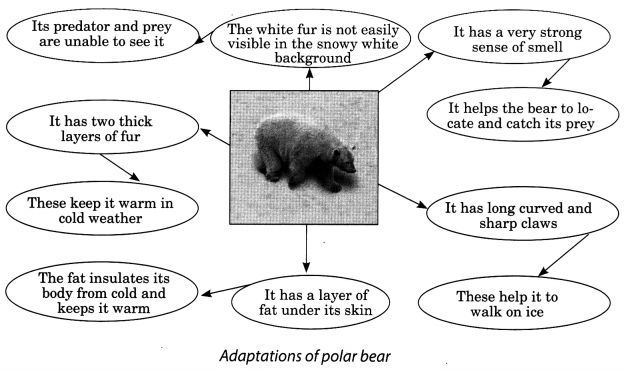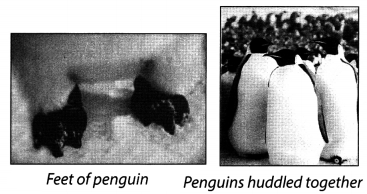In this page, we are providing Weather, Climate and Adaptations of Animals to Climate Class 7 Extra Questions and Answers Science Chapter 7 pdf download. NCERT Extra Questions for Class 7 Science Chapter 7 Weather, Climate and Adaptations of Animals to Climate with Answers will help to score more marks in your CBSE Board Exams.
Class 7 Science Chapter 7 Extra Questions and Answers Weather, Climate and Adaptations of Animals to Climate
Extra Questions for Class 7 Science Chapter 7 Weather, Climate and Adaptations of Animals to Climate with Answers Solutions
Weather, Climate and Adaptations of Animals to Climate Class 7 Extra Questions Very Short Answer Type
Question 1.
Why desert animals live in burrows?
Answer:
To escape hot and dry weather they live in burrows.
Question 2.
Name some animals found in polar regions.
Answer:
Penguins, polar bears, foxes and walrus.
Question 3.
The weather pattern of nearly how many years is called the climate of the place?
Answer:
25 years
Question 4.
Name some countries which belong to polar regions.
Answer:
Canada, Greenland, Sweden, Norway, etc.
Question 5.
Name the two regions of the earth having extreme climatic conditions.
Answer:
(i) Tropical region
(ii) Polar region
Question 6.
Name the major types of animals living in the rainforests.
Answer:
Monkeys, apes, gorillas, lions, etc.
Question 7.
Name an instrument used to measure rainfall.
Answer:
Rain gauge
Question 8.
What is weather?
Answer:
The day-to-day condition of the atmosphere at a place is called weather.
Question 9.
When does the minimum temperature of the day occur?
Answer:
In the early morning.
Question 10.
What does the daily weather report predict?
Answer:
The weather for the day.
Question 11.
Which department does prepare the weather reports?
Answer:
The Meteorological Department of the Government.
Question 12.
Who record the weather everyday?
Answer:
Meteorologists
Question 13.
What are the sources of getting daily weather reports?
Answer:
Television, radio and newspapers.
Weather, Climate and Adaptations of Animals to Climate Class 7 Extra Questions Short Answer Type
Question 1.
What is climate?
Answer:
The average weather pattern taken over a long time, say 25 years is called climate of the place. If we find that the temperature at a place is high most of the time, then we say that the climate of that place is hot.
Question 2.
How does the sun cause the change in the weather?
Answer:
The sun is a sphere of hot gases which is burning at a very high temperature. Shape of Earth is round and not flat so the sun’s ray don’t fall evenly on the land and oceAnswer:These differences in temperature create wind and water movement and play important role in determining the weather at any place.
Question 3.
What do you mean by the term adaptation?
Answer:
The modifications of the features and the functions of the body of plants and animals according to the climatic condition of a place where they are living is called adaptation.
Question 4.
Describe the climate of polar regions.
Answer:
The polar regions are covered with snow and it is very cold for most parts of the year. The sun does not set for six months and does not rise for six months. In winters, the temperature can be as low as -37°C. These regions are dominated by Earth’s polar ice caps.
Question 5.
How is the mean temperature for a given month calculated?
Answer:
The mean temperature for a given month is found in two steps. First we find the average of the temperatures recorded during the month. Second, we calculate the average of such average temperatures over many years. That gives the mean temperature.
Question 6.
What is a rain gauge?
Answer:
Rain gauge is an instrument to measure rainfall. It is basically a measuring cylinder with a funnel on top to collect rainwater.
Question 7.
What informations does the daily weather report give?
Answer:
The daily weather report gives information about the temperature, humidity and rainfall during the past 24 hours.
Question 8.
Why do we feel so miserable in the summer afternoon and comparatively comfortable early in the morning?
Answer:
The maximum temperature of the day occurs generally in the afternoon while the minimum temperature occurs generally in the early morning. We, therefore, feel so miserable in the summer afternoon and comparatively comfortable early in the morning.
Question 9.
Describe the climatic condition of the western region of India with the example of that of Rajasthan.
Answer:
The climatic condition of the western part of India, for example Rajasthan shows that the temperature is high during most part of the year. But during winter, which lasts only for a few months, the temperature is quite low. This region, receives very little rainfall. This is the typical desert climate. It is hot and dry.
Weather, Climate and Adaptations of Animals to Climate Class 7 Extra Questions Long Answer Type
Question 1.
Answer:
| Weather | Climate |
| (i) The day-to-day condition of atmosphere at a place is called weather. We say that the weather is not good today. | (i) The average weather pattern taken for over a long time is called climate. We can say that the climate of Ranchi is better than that of Delhi. |
| (ii) It can vary over a very short period of time. So it is recorded at very short interval on daily basis. | (ii) It does not vary in a short period of time. So it is recorded over a long time. |
Question 2.
Explain the adaptations of polar bears to live in polar regions. Give the flow chart also.
Answer:
The adaptations that make the polar bears suitable to live in polar region are:
- The long curved and sharp claws help polar bear to walk on ice.
- They also have a layer of fat under their skin. In fact, they are so well insulated that they have to move slowly and rest, often to avoid getting overheated.
- Polar bears have white fur on their body so that they are not easily visible in the snowy background.
- The two thick-layers of furs on the body of polar bear protects them from extreme cold.
- They have a strong sense of smell so that it can catch its prey for food.
The flow chart below clearly explain the adaptations of polar bears.

Question 3.
How are penguins adapted for cold climate?
Answer:
Following are the characteristics that make them suitable to live in cold climate.
- Penguins have a thick skin and lot of fat under them to protect them from cold.
- Their bodies are streamlined and their feet have webs, making them good swimmers (Fig. 7.2)
- Penguin have thick skin and a lot of fat to protect it from cold. It has white coat that merges well with the white background.
- They often huddled together to remain warm. (Fig. 7.3)

Question 4.
Write a short note on migration.
Answer:
Migration is physical movement of birds or animals from one area to another for food, space, breeding, escaping harsh condition, etc. Migration is commonly seen in birds living in extreme cold climate to long distances for warmer places during the winter season.
Siberian crane and Arctic tern are some of the migratory birds. Mammals, many types of fish and insects are also known to migrate seasonally in search of more hospitable climates.
Question 5.
Explain the climate of tropical regions.
Answer:
The tropical region has generally a hot climate because of its location around the equator. Even in the coldest month, the temperature is generally higher than about 15°C. During hot summers, the temperature may cross 40°C. Days and nights are almost equal in length throughout the year.
These region get plenty of rainfall. An important feature of the tropical region is the tropical rainforests. Tropical rainforests are found in Western Ghats and Assam in India, Southeast Asia, Central America and Central Africa.
Due to continuous warmth and rain, this region supports variety of animals and plants. For example, monkeys, apes, gorillas, tigers, elephants, leopards, lizards, snakes, birds, insects, etc. Many animals are adapted to living on the trees. Red-eyed frog has developed sticky pads on its feet to help it climb trees on which it lives.
To help them live on the trees, monkeys have long tails for grasping branches. Thus, many other animals have adapted to live in the tropical rainforests in tropical regions because of their characteristics like living on the trees, development of strong tails, long and large beaks, bright colours, sharp patterns, loud voice, diet of fruits, sensitive hearing, sharp eyesight, thick skin, ability to camouflage in order to protect themselves from predators, etc.
Weather, Climate and Adaptations of Animals to Climate Class 7 Extra Questions HOTS
Question 1.
Give one example of an animal that can live both in water and on land.
Answer:
Frog.
Question 2.
Write two common adaptive features of a polar bear which help in keeping it warm./
Answer:
- Thick layer of fat under its skin which insulates its body from cold and keeps it warm.
- Two thick layers of fur which keeps it warm.
Question 3.
What is huddling? How it keeps penguin warm in extreme cold climate?
Answer:
Huddling means to come together closely. When it is very cold, penguins huddle together in groups. Warm air gets trapped between the feathers and they get shielded from the full force of the cold wind outside. The penguins standing at the outside of the group continuously shuffle themselves inside to keep them warm. Thus, all penguins remain warm from extreme cold climate.
Question 4.
Mention two adaptive features in penguin which help it in swimming.
Answer:
Penguin have streamlined body and webbed feet which help it in swimming.
Question 5.
Why is it difficult to predict the weather of a place while it is easy to predict its climate?
Answer:
Climate is the average weather pattern taken over a long time, of a place so it is easy to predict. Weather is a complex phenomenon which can vary over a short period of time and thus is difficult to predict.
Weather, Climate and Adaptations of Animals to Climate Class 7 Extra Questions Value Based (VBQs)
Question 1.
A private zoo in tropical region thought of housing penguins to attract more tourists to its place. They arrange an artificial condition to keep them.
(a) Do you think penguins will be able to survive? Why?
(b) What is the difference between the two habitats, i.e., where penguins live and where they will be shifted?
(c) What kind of artificial conditions will be needed to house penguins in tropical region?
(d) Do you agree with the steps taken by the zoo?
(e) What value of private zoo is shown here?
Answer:
(a) No, because they are adaptive to extreme cold climate.
(b) Temperature is the main difference between the two habitat.
(c) Cold temperature, fish, length of days, climate and vegetation, etc.
(d) No because they are doing for their private profit and risking the lives of penguins.
(e) They seems to be money minder, selfish, etc.